Fast Casual Restaurant Market Research, 2032
The global fast casual restaurant market was valued at $124.5 billion in 2022, and is projected to reach $337.8 billion by 2032, growing at a CAGR of 10.4% from 2023 to 2032.
A fast casual restaurant market refers to a type of restaurant that offers quick service and typically focuses on inexpensive and standardized menu items. The menus offered by these restaurants have a range of options such as salads, sandwiches, wraps, bowls, and sometimes even limited alcoholic beverages. It typically has a limited menu of items that are made to order, and it basically consists of freshly prepared convenient food options to cater diverse customers segments. Fast-casual restaurants often provide a more pleasant and comfortable dining environment as compared to fast food outlets. They have seating areas with modern or rustic decor, and some offer amenities such as free Wi-Fi.
MARKET DYNAMIC
The fast casual restaurant market growth is majorly driven due to low barriers to entry from the competitors and the potential for high profits, which has led to a proliferation of such restaurant chains in both developed and developing economies across the world. One significant development that has revolutionized the restaurant industry is the introduction of cloud kitchens which requires minimal investments. Thus, by reducing capital expenditure, it has made it more feasible for businesses to establish fast casual restaurants. This lower initial investment requirement, coupled with the possibility of higher profit margins has attracted investments in the fast casual restaurant sector. Fast casual restaurants typically require an upfront financial cost that creates an environment conducive for entrepreneurs and investors those who seeks to enter the market. Many fast casual chains invest in technology to streamline their operations offering features, such as online ordering, delivery services and improved customer engagement, which helps to improve customer convenience. Moreover, the increased automation in kitchen operations and the rise of door-to-door delivery services create new growth opportunities for cloud kitchens on a global scale. In addition, the availability of franchise opportunities within the fast-casual restaurant sector simplifies the replication of successful concepts in various locations, accelerating the expansion of fast-casual chains. Consequently, the combination of a low entry barrier and the potential for substantial profits is expected to drive rapid growth within the fast casual restaurant industry.
Fast casual restaurants provide a premium dining experience compared to quick service restaurants (QSRs); however, this experience often comes at a higher price point. This pricing structure tends to narrow their target customer base to individuals with higher incomes who are willing to invest in fresh, customized meals. Moreover, uncertainties surrounding the current and future economic landscape significantly impact the foot traffic and overall performance of fast casual restaurants. These uncertainties result from various factors. These include the economic recession, shifts in consumer spending habits, along with the rapidly changing competitive landscape within the fast-casual dining industry. Furthermore, when individuals experience job loss or insecurity, they tend to limit discretionary expenses such as eating out or ordering takeout. Furthermore, this shift in consumer behavior result in a decline in customer visits and revenue for fast casual restaurants, potentially impede the growth of the market during the fast casual restaurant market forecast.
The food service industry has experienced a significant shift toward adopting technology to improve operational efficiency. Thus, by implementation of scheduling software, digital inventory tracking, automated purchasing tools, and digital reservation table managers, the industry has seen substantial improvements in revenue generation, inventory management, customer satisfaction, and overall operation efficiency. This incorporation of technological solutions provides lucrative opportunities for customers in fast casual restaurants to effectively manage queues, inventory levels, purchases, and other essential operations. These fast casual restaurants such as Chipotle, White Castle, and Wing Zone are using automation to streamline processes such as pizza preparation and frying, resulting in increased convenience, reduced labor costs, and quicker food delivery to customers. This advanced technology holds great potential for the market by offering improved efficiency and faster service.
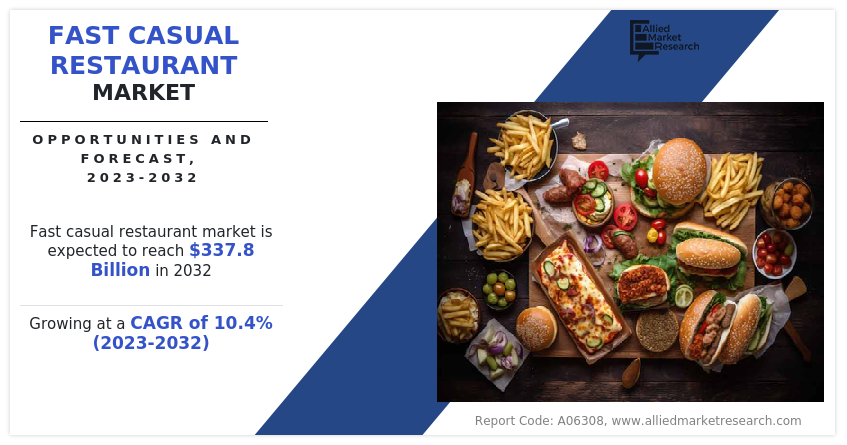
SEGMENTAL OVERVIEW
The fast casual restaurant market is segmented on the basis of food type, mode of operation, nature, and region. By food type, the market is segregated into burger/sandwich, pizza/pasta, Asian/Latin American food, chicken, others. As per mode of operation, it is divided into dine-in and takeaway. By nature, the market is bifurcated into franchised and standalone. Region wise, it is analyzed across North America (U.S., Canada, and Mexico), Europe (UK, Germany, France, Italy, Spain, and rest of Europe), Asia-Pacific (China, India, Japan, Asean, and rest of Asia-Pacific), and LAMEA (Latin America, Middle East, and Africa).
BY FOOD TYPE
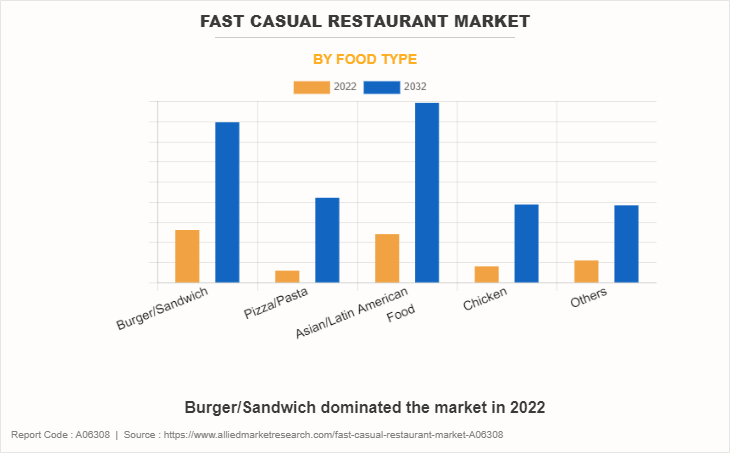
Based on the food type, the burger/sandwich segment dominated the market, garnering a market share of 29.1% in 2022. All these factors are expected to boost the demand for the burger and sandwich segment during the forecast period. The high market share in the burger and sandwich segment is attributed to convenience and easy availability in restaurants. Most fast-food restaurants serve burgers and sandwiches to their consumers. The short preparation time of these products makes them popular among consumers. Due to a hectic lifestyle and busy schedules, consumers are shifting toward products like burgers and sandwiches. The trend toward fusion cuisine and the convenience of takeout & delivery services has further boosted demand in the market. Moreover, growth in the fast casual restaurant market is fueled by flavor innovation, including experimentation with various toppings and stuffings, and by catering to health-conscious consumers with plant-based options. Furthermore, a variety of bread choices, sauces, and additional stuffings offered by restaurants allows customers to customize their sandwiches and burgers to their preferences. This contributes to market growth during the forecast period.
BY MODE OF OPERATION
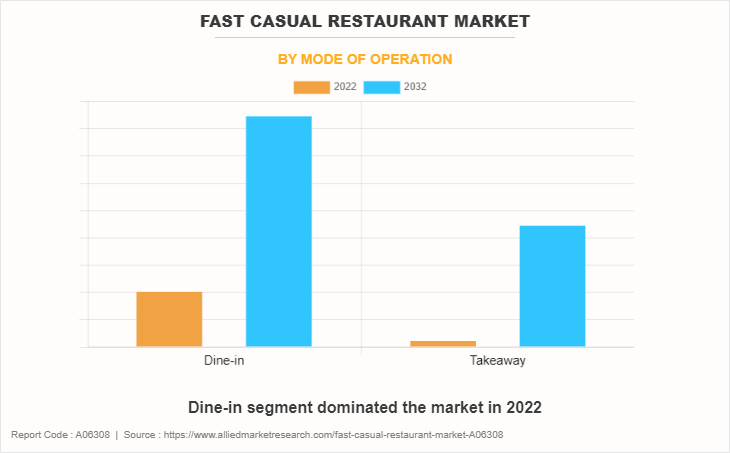
Based on mode of operation, the dine-in segment dominated the market, garnering a market share of 64.5% in 2022. The dine-in segment holds a significant portion of the fast-casual restaurant market, contributing to a higher overall value. These restaurants, where food operators use to market and sell their food products within their own restaurant premises, stand out by offering counter service in a sophisticated and pleasant atmosphere. They prioritize customization, freshly prepared dishes, and a commitment to deliver high-quality cuisine. Millennials are driving a notable transformation in the dine-in experience. There is a fundamental shift in their values, with a strong emphasis on societal and environmental responsibility. Moreover, they seek a novel restaurant experience that places a substantial focus on locally sourced food, convenient menu options, sustainability practices, and reasonable prices for food. Millennials seek unique dining experience while giving preference for exquisite flavors, locally sourced and natural ingredients & raw material, which drives the growth of this segment. Furthermore, fast-casual restaurants have witnessed remarkable growth both in terms of revenue and customer traffic owing to the change in consumer lifestyle and developing economic condition across the world. Thus, it is expected that the fast casual restaurant market size may grow rapidly in the dine-in segment and will maintain its dominace throughout the forecast period.
BY NATURE
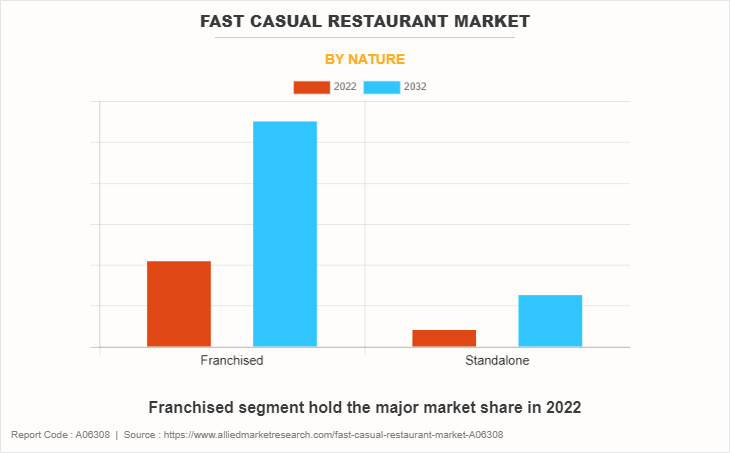
Based on nature, the franchised segment dominated the market, garnering a market share of 83.5% in 2022. Franchising serves as a fundamental strategy for rapid business expansion for many big restaurants. Under this approach, the franchisor grants licenses to third parties, allowing them access to the proprietary procedures, expertise, business model, intellectual property, brand, and the right to sell branded products and services of franchisor in exchange for specified fees. This global practice is instrumental in the expansion of market presence and helps to broaden the customer base. Businesses that operate with a structured approach, boasting multiple branches in both domestic and international markets, are commonly referred to as franchised fast casual restaurants. In addition, these restaurants offer unique product offerings tailored exclusively for their respective locations, which cannot be replicated or promoted by other operators.
Leading brands in the fast casual restaurant sector actively use franchising to expand their geographic footprint and reach a wider audience. Franchised fast casual restaurants hold a significant market share, owing to their huge and loyal customer base. These restaurants feature unique trademarks that are utilized for promotional purposes and product sales. Moreover, they often offer various customer loyalty programs for customers who frequently visits the restaurant. For instance, Panera, with over 2,169 outlets worldwide, offers various loyalty programs to reward its regular customers. This brand supports franchising to scale up operations and expand its customer base. Similarly, Jimmy John's Gourmet Sandwiches is pursuing a franchising strategy to increase its reach among consumers. Thus, the franchised segment is expected to thrive and expand while contributing to fast casual restaurant market demand in the anticipated period.
BY REGION
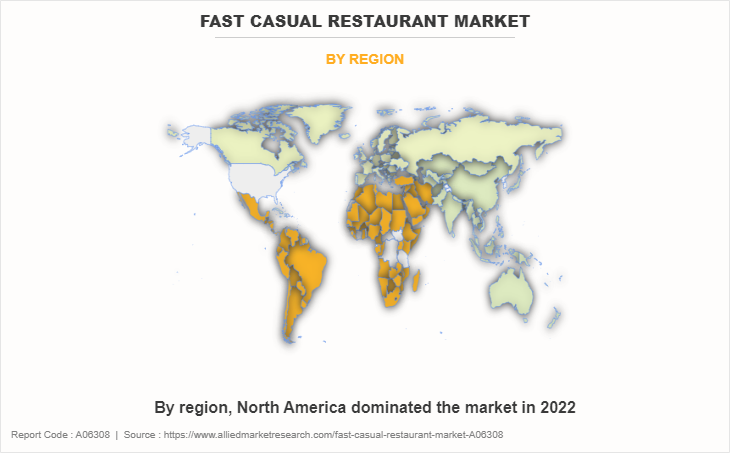
Based on region, North America dominated the market, garnering a market share of 45.1% in 2022. In North America, consumers have rapidly shifted their food preferences towards healthier options. Consumer tastes, habits, and buying behavior are evolving swiftly in this region. Several factors, including rising labor costs, high interest rates, and sustained economic growth, create a complex operational landscape for fast casual restaurant market players. Consequently, established companies face fierce competition from well-funded and proactive disruptors in the industry. Key players in the market continue to benefit from the trend of Americans increasingly relying on fast casual restaurants due to their busy schedules and fast-paced lifestyles. Companies have adapted in terms of functioning by the introduction of innovative menus, business models, operations, and technology to thrive in this competitive environment. For instance, Shake Shack's menu offers a diverse range of options, including burgers made from 100% all-natural Angus beef, chicken sandwiches, hot dogs, and various vegetarian choices. Consumers in the region now favor natural, clean-label, and organically grown food, which has driven the fast casual restaurant market share in North America.
Moreover, the region has experienced an increase in health conditions such as diabetes and obesity, which has prompted high awareness regarding nutritious, low-calorie dietary options. Furthermore, a rise in prevalence of food allergies has derived the need for customized and personalized meal solutions that address the specific needs of individual customers. As a result, consumers make conscious decisions related to their food choices, further boosting their preference for fast casual restaurants.
Asia-Pacific is expected to be the fastest growing market for fast casual restaurant during the forecast period. The rapid expansion of the middle class and the working population is a significant driver of growth in the Asia-Pacific fast casual restaurant market. These restaurant chains maintain a balance between affordability and quality, making them an appealing option for customers in the region. The working-class population favors fast casual dining due to its speedy and convenient cooking features. Furthermore, the integration of technology, including mobile apps and online ordering platforms, has streamlined the order and delivery process for fast casual restaurants. The region has witnessed a surge in the popularity of food delivery and takeout services, driven by convenience and shifting consumer preferences. Fast casual restaurants have responded by offering efficient delivery solutions to different customer segments. The Asia-Pacific market holds immense growth potential, as these chains continuously introduce new and innovative product offerings along with regular discounts and other attractive offers for customers. As a result of the low penetration rate of fast casual restaurants in this region, there are ample growth opportunities for key players to establish a first-mover advantage in the market.
COMPETITION ANALYSIS
Chipotle Mexican Grill, Wingstop Restaurants, Inc., EXKI SA, Panda Restaurant group, Inc., Five Guys Enterprises, LLC., Famous Brands Limited, Restaurant Brands International Inc., Zaxby’s Franchising LLC., Erbert & Gerbert’s Sandwich Shop, and Tortilla Mexican Grill PLC. are the major companies profiled in the fast casual restaurant market report. These key players are constantly engaged in various developmental strategies such as partnerships, mergers, and acquisitions to gain a competitive edge and exploit the prevailing fast casual restaurant market opportunities.
Recent Innovation in the Fast Casual Restaurant Market
- In April 2023, Chipotle Mexican Grill has announced an innovative electric-powered restaurant design as part of its strategic commitment to advance towards its science-based targets. These targets, which are in alignment with the Science Based Targets initiative (SBTi), aim to achieve a 50% reduction in both direct and indirect greenhouse gas emissions by the year 2030.
Recent Partnership in the Fast Casual Restaurant Market
- In January 2022, Tortilla in partnerships with Applewood Vegan, vegan cheese brand, to promote plant-based menu options to provide vegan food dishes at more than 50 restaurants across the UK.
Recent Product Launch in the Fast Casual Restaurant Market
- In October 2022, Zaxby's introduced its new Chicken Bacon Ranch Loaded Fries systemwide after successfully testing the saucy sharable in select markets to expand their product portfolio with addition of variety of food menu with different flavors.
- Chipotle Mexican Grill launched five new lifestyle bowls, which provided healthy menu items during the COVID-19 shut-ins.
Recent Expansion in the Fast Casual Restaurant Market
- In May 2023, Restaurant Brands International and McWin announced the expansion of Burger King brand in Czech Republic, Poland, and Romania, and it also looks forward to bringing the restaurant brand, Popeyes in Czech Republic and Poland, with plans to open 600 restaurants throughout these countries over the next 10 years.
- In June 2023, Zaxby's opened its first franchise-owned, to-go-only restaurant in Hoover, Alabama to serve customers with experience of quick drive-thru service through a double drive-thru layout with a new digital menu board, a payment window, along with a drive-thru delivery door for faster pay and pickup.
- In March 2020, U.S. chicken wing brand Wingstop opened its third UK restaurant, and first outside London, in the Winter Garden at Bluewater in Kent.
Key Benefits For Stakeholders
- This report provides a quantitative analysis of the market segments, current trends, estimations, and dynamics of the fast casual restaurant market analysis from 2022 to 2032 to identify the prevailing fast casual restaurant market opportunities.
- The market research is offered along with information related to key drivers, restraints, and opportunities.
- Porter's five forces analysis highlights the potency of buyers and suppliers to enable stakeholders make profit-oriented business decisions and strengthen their supplier-buyer network.
- In-depth analysis of the fast casual restaurant market segmentation assists to determine the prevailing market opportunities.
- Major countries in each region are mapped according to their revenue contribution to the global market.
- Market player positioning facilitates benchmarking and provides a clear understanding of the present position of the market players.
- The report includes the analysis of the regional as well as global fast casual restaurant market trends, key players, market segments, application areas, and market growth strategies.
Fast Casual Restaurant Market Report Highlights
| Aspects | Details |
| Market Size By 2032 | USD 337.8 billion |
| Growth Rate | CAGR of 10.4% |
| Forecast period | 2022 - 2032 |
| Report Pages | 289 |
| By Food Type |
|
| By Mode of Operation |
|
| By Nature |
|
| By Region |
|
| Key Market Players | Restaurant Brands International Inc., Tortilla Mexican Grill PLC., EXKI SA, Zaxby’s Franchising LLC, Panda Restaurant group, Inc., Wingstop Restaurants, Inc., Famous Brands Limited, ERBERT & GERBERT’S SANDWICH SHOP, Chipotle Mexican Grill, FIVE GUYS ENTERPRISES, LLC. |
Analyst Review
According to the CXOs, the performance of the key players highlights that the brand and value proposition of the companies continue to be robust, even in the face of a challenging economic environment. They further added that as consumer discretionary spending tightens, the companies are expected to continue to maintain excellent restaurant operations and ensure top-notch customer & employee experiences. In the dynamic landscape of the fast casual restaurant market, key industry leaders are strategizing to maintain alignment with the rapid evolution of this sector.
Their primary objective is to offer customers a repertoire of innovative and delectable food selections, all within a convenient and comfortable dining environment. The overarching sentiment among top CEOs is one of optimism regarding the long-term growth prospects of the fast casual restaurant market. Achieving this growth hinges on businesses' ability to adapt to groundbreaking concepts and maintain an unwavering focus on enhancing the customer experience. Furthermore, the fast casual restaurant market has been substantially influenced by consumer preferences, notably a significant demand for food options that are not only healthier but also more cost-effective, convenient, and customizable. This surge in consumer interest has catalyzed the expansion of the fast casual restaurant industry. A notable trend in this realm is the increasing reliance on digital platforms for food ordering and delivery services. This shift presents a unique opportunity for fast casual restaurants to deliver swift and hassle-free dining experiences.Furthermore, consumers have exhibited a growing affinity for plant-based and sustainable food alternatives. In response, fast casual restaurants are augmenting their menus with an array of plant-based offerings and forging partnerships with suppliers committed to sustainable practices.
The global fast casual restaurant market was valued at $124.5 billion in 2022, and is projected to reach $337.8 billion by 2032
The global Fast Casual Restaurant market is projected to grow at a compound annual growth rate of 10.4% from 2023 to 2032 $337.8 billion by 2032
Chipotle Mexican Grill, Wingstop Restaurants, Inc., EXKI SA, Panda Restaurant group, Inc., Five Guys Enterprises, LLC., Famous Brands Limited, Restaurant Brands International Inc., Zaxby’s Franchising LLC., Erbert & Gerbert’s Sandwich Shop, and Tortilla Mexican Grill PLC. are the major companies profiled in the fast casual restaurant market report.
Based on region, North America dominated the market, garnering a market share of 45.1% in 2022.
Changing consumer preference toward fast casual restaurants, Low entry barriers and high profits resulting in rapid proliferation of fast casual chains in both developing and developed economies, Rise of food delivery platforms
Loading Table Of Content...
Loading Research Methodology...



